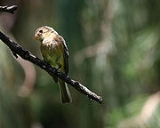
Buff-breasted Flycatcher
Encyclopedia
The Buff-breasted Flycatcher, Empidonax fulvifrons, is a small insectivorous bird
. It is the smallest Empidonax
flycatcher
, typically ranging from 11.5 to 13 cm (4.5 to 5 in.) in size.
Adults have olive gray upper bodies, darker coloration on the wings and tail, conspicuous white eye rings, white wing bars, small bills, and short tails. The breast of this species is distinctive, washed with a strong orange buff color.
Their preferred breeding habitat is scrub and open woodlands. They usually make a cup nest in the forks of trees. Females usually lay two eggs at a time.
The range of the Buff-breasted Flycatcher extends from extreme southeastern Arizona
in the United States
through Mexico
to southern Honduras
.
These birds are partial migrants
, retreating from their northern breeding areas in the United States and northern Mexico for the winter.
To feed, they often wait on an open perch of a shrub or low branch of a tree and fly out to catch insects in flight. They also sometimes pick insects from foliage while hovering.
The song is an alternating versed PIdew, piDEW. The call is a loud dry pit.
Bird
Birds are feathered, winged, bipedal, endothermic , egg-laying, vertebrate animals. Around 10,000 living species and 188 families makes them the most speciose class of tetrapod vertebrates. They inhabit ecosystems across the globe, from the Arctic to the Antarctic. Extant birds range in size from...
. It is the smallest Empidonax
Empidonax
The genus Empidonax is a group of small insect-eating passerine birds in the tyrant flycatcher family, the Tyrannidae.Most of these birds are remarkably similar in plumage: olive on the upper parts with light underparts, eye rings and wing bars...
flycatcher
Tyrant flycatcher
The tyrant flycatchers are a family of passerine birds which occur throughout North and South America. They are considered the largest family of birds on Earth, with more than 400 species. They are the most diverse avian family in every country in the Americas, except for the United States and...
, typically ranging from 11.5 to 13 cm (4.5 to 5 in.) in size.
Adults have olive gray upper bodies, darker coloration on the wings and tail, conspicuous white eye rings, white wing bars, small bills, and short tails. The breast of this species is distinctive, washed with a strong orange buff color.
Their preferred breeding habitat is scrub and open woodlands. They usually make a cup nest in the forks of trees. Females usually lay two eggs at a time.
The range of the Buff-breasted Flycatcher extends from extreme southeastern Arizona
Arizona
Arizona ; is a state located in the southwestern region of the United States. It is also part of the western United States and the mountain west. The capital and largest city is Phoenix...
in the United States
United States
The United States of America is a federal constitutional republic comprising fifty states and a federal district...
through Mexico
Mexico
The United Mexican States , commonly known as Mexico , is a federal constitutional republic in North America. It is bordered on the north by the United States; on the south and west by the Pacific Ocean; on the southeast by Guatemala, Belize, and the Caribbean Sea; and on the east by the Gulf of...
to southern Honduras
Honduras
Honduras is a republic in Central America. It was previously known as Spanish Honduras to differentiate it from British Honduras, which became the modern-day state of Belize...
.
These birds are partial migrants
Bird migration
Bird migration is the regular seasonal journey undertaken by many species of birds. Bird movements include those made in response to changes in food availability, habitat or weather. Sometimes, journeys are not termed "true migration" because they are irregular or in only one direction...
, retreating from their northern breeding areas in the United States and northern Mexico for the winter.
To feed, they often wait on an open perch of a shrub or low branch of a tree and fly out to catch insects in flight. They also sometimes pick insects from foliage while hovering.
The song is an alternating versed PIdew, piDEW. The call is a loud dry pit.
Subspecies
Various subspecies are recognized:- Empidonax fulvifrons pygmaeus Coues, 1865 (Northern Buff-breasted Flycatcher or Fulvous Flycatcher)
- Empidonax fulvifrons fulvifrons (Giraud, 1841)
- Empidonax fulvifrons rubicundus Cabanis & Heine, 1859
- Empidonax fulvifrons brodkorbi Phillips, AR, 1966
- Empidonax fulvifrons fusciceps Nelson, 1904
- Empidonax fulvifrons inexpectatus Griscom, 1932
Names in other languages
- Spanish: Mosquerito canelo, Mosquero pechianteado, Mosquero Pecho Leonado, Mosqueta de Pecho Canela, Mosquerito canelo, Mosquero Pechicanelo
- French: Moucherolle à poitrine fauve
- German: Braunbrusttyrann, Braunbrust-Tyrann
- Dutch: Blonde Feetiran
- Italian: Pigliamosche pettocamoscio
- Finnish: Rusorintasieppari
- Czech: Tyranovec hnedocelý
- Polish: Empidonka płowa

